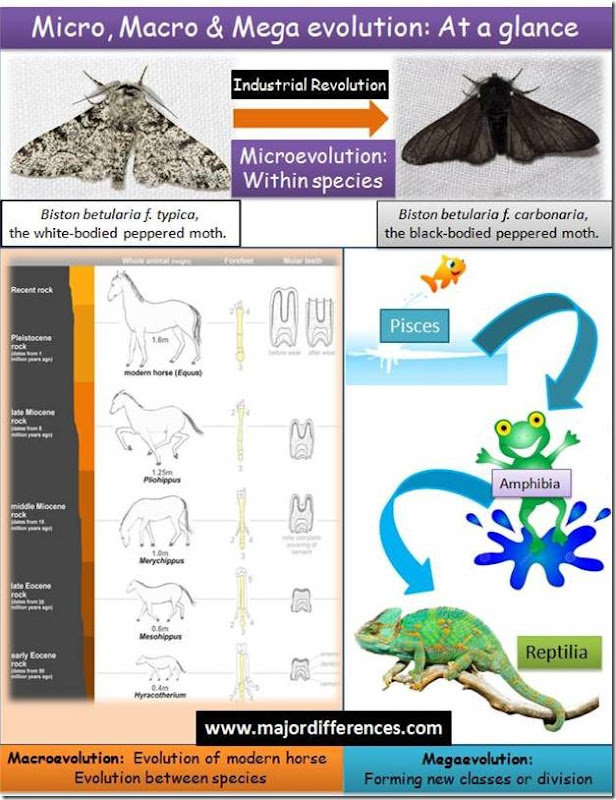Evolution is a slow, step by step irreversible change or transformation, from simple to more complex or advanced, occurring in time and space.
The process of evolution can be broadly classified into two
1. Inorganic evolution: Which refers to the evolution of the living world.
2. Organic evolution: Which refers to the evolution of the non-living world.
Microevolution
1. It is the evolutionary change happening below the level of species.
2. Microevolution produces differences between different populations of a species (within species).
3. Microevolution over time may result in the formation of sub-species or geographical races.
4. The most common driving force of microevolution is natural selection in response to different environments.
Examples: Variety of beak shape among the finches of Galapagos island.
Colour change in peppered moth in England during Industrial Revolution.
Evolution of DDT resistant Insect populations.
Evolution of antibiotic resistant bacteria*.
All examples are changes occurring within a population in response to changing environment.
Macroevolution
1. It is the evolutionary change happening at or above the level of species.2. Macroevolution occurs between species.
3. Macroevolution over time may result in the formation of new species, genera, families, orders etc..
4. The evolutionary changes occurring in macroevolution is massive, involving macromutation, genetic divergence and adaptive radiation, producing major changes above species level.
Examples: Evolution of modern horse (Equus equus) from the genus Eohippus, which was less than 11 inches in height.
Evolution of birds from dinosaurs**
Evolution of tetrapods (animals with four legs) from fish**
Megaevolution
1. It is the large scale evolutionary change happening at the level of class and phyla or division.2. Megaevolution is a rare phenomenon, occurred only very few times in the entire evolutionary history of life.
3. Megaevolution may result in the formation of new biological organizational system, as new classes or divisions.
4. The actual process leading to megaevolution is not known as the phenomenon is extremely rare.
Examples: Origin of plants, animals and microorganisms
All these divisions are unique with distinctive biological organization.
Bacterial cells (Prokaryotes), leading to Eukaryotic cells with true nucleus and organelles
Evolution of Fungi, plants and animals from unicellular organisms
Evolution of amphibians from fishes.***Evolution of reptiles from amphibians.***
Evolution of birds and mammals from reptiles.***
All the above groups belongs to different classes as Pisces, Amphibia, Reptilia, Aves and Mammalia respectively.
Remember, all the above terms are abstract and citing a clear cut example is often impossible. Evolutionary biologists greatly differ in their opinions.
Reference
*Russell, P., Hertz, P., & McMillan, B. (2013). Biology: the dynamic science. Cengage Learning.
**Starr, C., Evers, C., & Starr, L. (2010). Biology: Concepts and Applications Without Physiology. Cengage Learning.
***Yadev, B. N., & Kumar, D. (2000). Vertebrate zoology and evolution. Daya Books.
Image credits:
- "Biston.betularia.f.carbonaria.7209". Licensed under CC BY-SA 3.0 via Wikimedia Commons -
- "Horseevolution" by Original uploader was Mcy jerry at en.wikipedia Later version(s) were uploaded by Obli at en.wikipedia. - Licensed under CC BY-SA 3.0 via Wikimedia Commons
- All clip arts from http://cliparts.co

Microevolution and Macroevolution
ReplyDeleteMost science websites I have looked at list Darwin’s finches as an example of macroevolution. How can that be an example of “macro” change when it is still a finch? It isn’t even a different type of bird.
Arv Edgeworth
Post a Comment
We Love to hear from U :) Leave us a Comment to improve this site
Thanks for Visiting.....